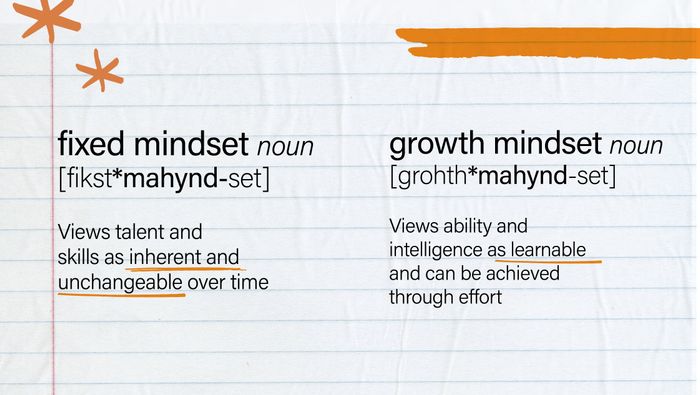How to cultivate a growth mindset through language
Three ways to ensure you’re attracting people who will help your organisation to grow.

- 5 minute read
- DE&I
- Talent Attraction
A big part of how I learned about growth mindset came first-hand when teaching my son. I would see him struggle with a challenge and want to help him in the best way I could. As a child, learning with a growth mindset means being more likely to persevere in the face of a setback, seeking out new challenges, and learning from your mistakes. It also leads to an increase in self-esteem because you believe in yourself and know how capable you are of learning and growing.
A growth mindset is the knowledge that intelligence and talent can be nurtured and developed with practice and effort. A fixed mindset on the other hand, is when you think that talent and skills are finite. You were either born being able to do something or you were not. And there’s nothing you can do to change this.
Naturally, I want my three-year-old to know that the more he practices, the better he will get at a task. But how does this translate to the workplace?

Why is a growth mindset important?
We live in a world that is constantly changing, and organisations must adapt and grow to succeed. So do the people who work for them. Brands regularly look to innovate to stay fresh in the market. It’s important for their workforce to be able to try new ideas, learn from any mistakes and keep moving forward.
Improve resilience
Promoting a growth mindset at work can help employees to adapt in the face of difficult circumstances and make them more resilient in the face of change. This can lead to better mental health and wellbeing both at work and at home. So, it’s clear that this kind of mindset has multiple benefits both for organisations and the people who work for them.
Positive perceptions
Research by Dr Mary Murphy focused on undergraduates’ perception of employers and studied how men and women felt about reading a fixed and a growth version of a company’s mission statement. It showed that both men and women trusted the growth company more, and that for women the difference was greater. Most importantly, women distrusted the fixed mindset company because they believed they would fall foul of stereotypes, be perceived as less competent and wouldn’t be able to progress.
Diversity hiring
When it comes to recruitment, there is evidence that growth mindset language has a positive impact when hiring women. In 2016, a study by Paradigm and Textio showed that jobs where women were hired were twice as likely to contain growth mindset language in the job description.
Where to start with growth-mindset language?
If you want to convey your organisation’s commitment to growth thinking, it should be present in everything you do – from the culture to your employer brand, the learning and development you offer to the way you recruit. And often this comes down to more than just using one word instead of another. It’s about what you convey with your words that matters.
Here are three ways to start thinking about the language you use, no matter what you’re writing
1. Write about skills as being fluid not finite
Whether you need to explain the skills your team has or you’re detailing what you’re looking for in a candidate, try to avoid limited words and phrases like ‘talented’, ‘highly intelligent’ or ‘the best and the brightest’. Instead, opt for words that focus on effort like ‘highly motivated’, ‘passionate’ and ‘hard-working’.
Show examples of how skills and talent can develop over time. Make it clear that practice and effort matter and that everyone has the potential for change.
2. Focus on growth
Place an emphasis on training, learning and development, so that candidates can see a potential for growth and employees feel supported.
Talk about the challenges your business or team face and how they help the organisation to grow.
Show how both change and failure can offer opportunity. Don’t be afraid to speak about how mistakes can be learning opportunities. Whether you’re writing about a project or detailing what’s needed from a candidate, be clear that you’re focused on the journey and the process, not just the outcome. That way, everyone knows they have the chance to anticipate issues and respond to them.
Include words and phrases like ‘Open to learning and change’, ‘adaptable’ and ‘strive’.
3. Celebrate everyone’s success
A growth mindset isn’t just about the individual. Talk about how your team and organisation can grow together and learn from one another – you’re stronger together. People with a growth mindset are inspired by what they see others accomplish, so show examples of how your people have succeeded.
Don’t forget about feedback too. Make sure there’s an emphasis on constructive feedback that helps everyone learn and move forward together.
Lastly, encourage your people to speak up and share perspectives and ideas. Make it clear in your writing that all opinions matter.
Want to know more about how to approach diversity, inclusion and equality within your communications? Get in touch with us at diversity@thirtythree.co.uk.





